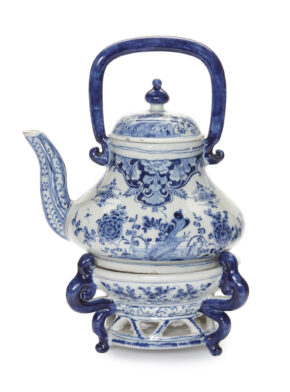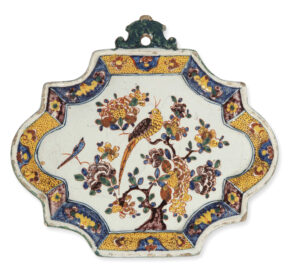[popup_trigger id=”13756″ tag=”span”]![]() [/popup_trigger]
[/popup_trigger]
Images on this website are licensed under a
Creative Commons Attribution-NoDerivs 3.0 Unported License.
OBJECT
• D2209. Red Stoneware Teapot and Cover
Delft, circa 1700
Each marked LVE and the numerals 2 and 4 in blue for Lambertus van Eenhoorn, the owner of De Metaale Pot (The Metal Pot) factory from 1691 until 1721, or his widow Margaretha Teckmann until 1724
The spherical body applied on either side with a relief-molded floral sprig, and the domed cover with three flower heads encircling the pierced ball knop.
DIMENSIONS
Lengths: 17.3 cm. (6.8 in.)
PROVENANCE
The Collection of Mrs. Ella B. Schaap (1913-2021), author and former Curatorial Associate in the field of European Ceramics at the Philadelphia Museum of Art, Philadelphia, U.S.A.
NOTE
Although the trade of Chinese porcelain by the VOC (Dutch East India Company) became difficult from around 1650, because of the civil unrests in China, the VOC still managed to maintain trade relations with the southern part of China. They imported wares, such as porcelain, tea and the famous red stoneware teapots. Once again, these Chinese objects formed the inspiration for the red stoneware teapots of Delft.
Red clays exist plentifully nearly everywhere in the world, but it was in the Yixing region, north of Shanghai, where since the Sung dynasty (960-1279) a red clay with a high kaolin content had been used with particular success for the making of teapots. Since the stoneware material retained the beverage’s warmth and fragrance, these stoneware teapots were sought after. The small pots would be used as infusion pots (trekpotjes), and once poured into the cup, the strong tea would be diluted with water from a larger kettle on a brazier. The preparation of tea in Yixing teapots was a well established tradition in the Shanghai region long before tea as a beverage was encountered by Dutch colonists around 1640 in Batavia (now Jakarta). Immediately the VOC began including tea in its cargoes to the Netherlands, and by 1685, its private trade in the commodity had reached such dimensions that they decided to establish a monopoly on the tea trade with Europe, and the importation of Yixing red stoneware teapots was a natural corollary.
Capitalizing on the popularity of this latest fashionable beverage, and on the successful properties of the Yixing stoneware teapots, several Delft potters decided to turn their talents to the imitation of this so sought-after red stoneware. However, once again the potters had to overcome several technical problems. First of all the composition of the clay. The material had to be suitable to make unglazed pottery with it, which had to be more or less watertight. The denser and more refined red clay was fired at a higher temperature than the yellowish clay used for the tin-glazed wares, and in the process it became impenetrable, obviating the need for a layer of glaze to make it impervious to liquids. Also, the imitation had to be close to the Chinese object in color and hardness. Furthermore there was the obstacle of the adaptation of those clays to their own familiar production techniques. The Chinese potters traditionally formed their pots by modeling slabs of clay with their hands, enabling them to create a variety of unusual shapes, whereas the Dutch potters were accustomed to throwing their vessels on a wheel, resulting in circular, ovoid or cylindrical shapes. Fortunately for the Delft potters, wheel- throwing created forms suitable for teapots, but it explains why so few other forms were created in this red clay body. That is the reason why only the ‘simple Chinese models’ were eligible as an example of the Delft imitations.
At least three Delft potters tried to imitate the Yixing teapots: Lambertus Cleffius, the owner of De Metaale Pot (The Metal Pot) factory, his cousin Samuel van Eenhoorn, the owner of De Grieksche A (The Greek A) factory, and Samuel’s father’s former assistant, Ary de Milde. In the year 1678 Cleffius placed an advertisement in the Haarlemse Courant (the newspaper of the city of Haarlem) in which he credited himself for the invention of the red teapots, which according to the description could compete in color, beauty, strength and use with the Indische thee- potten (Chinese teapots). However Van Eenhoorn and De Milde made similar claims, and requested in 1679 a patent from the Staten van Holland to protect their wares. To avoid controversy and ill will, the board in The Hague that determined the issuance of patents, decided to compromise, and rather than permit one patent only, they allowed each of the potters to use his own mark to distinguish his wares from those of his competitors.
Although these three potters experimented with the red stoneware, De Milde en Jacobus de Caluwe are the two names most prominently associated with the red stoneware. This is largely because their products are so frequently marked. De Milde, who was called ‘Master teapot maker’, of De Gecroonde Theepot (The Crowned Teapot) produced red teapots from circa 1680 until his death in 1708, after which his daughter continued the business under his name until 1724. Characteristic for De Milde are applied blossom sprigs on an even spherical ground, whereas De Caluwe teapots can be recognized by impressed lines alternating with small floral appliques. In 1702 Jacobus de Caluwe bought part of the defunct Delftware factory of ‘De Dissel’ from Judith van Eenhoorn, the widow of Adrianus Kocx, and before 1706 resumed operations with the production of red stoneware teapots. Like De Milde, his output was predominantly Yixing-style teapots, of which he made a variety of sizes, but in 1707 he was accused by local officials of making pots larger than he was allowed to produce.
After the death of the third Delft potter experimenting with red stoneware Lambertus Cleffius, De Metaale Pot factory was sold to Lambertus van Eenhoorn in 1691. In contrast to De Milde and De Caluwe, the output under Van Eenhoorn was much more varied than just red stoneware teapots. During his ownership he quickly became one of the most important Delftware potters of his time, adapting his production to the public’s taste and maintaining the integrity of his factory’s reputation. Through his influence, Lambertus van Eenhoorn gave De Metaale Pot factory its enduring fame for beautiful and innovative designs. De Metaale Pot factory continually innovated their eclectic production to create complex shapes and decorations in all sorts of color palettes, from the reeded cashmere palette to colored ground and even red stoneware.
SIMILAR EXAMPLES
Red stoneware teapots marked for Lambertus van Eenhoorn are rare. According to our information only five other teapots are known, one in Dresden, another two in a Dutch private collection. Two other teapots are housed in the Groninger Museum, Groningen. The decoration of one teapot shows plumblossoms and a sitting Buddha figure applied in relief (inv. no. 1988.0223) and the other of smaller size (height 11 cm. [4.3 in.] is molded with floral sprigs (inv. no. 1949.0098).









